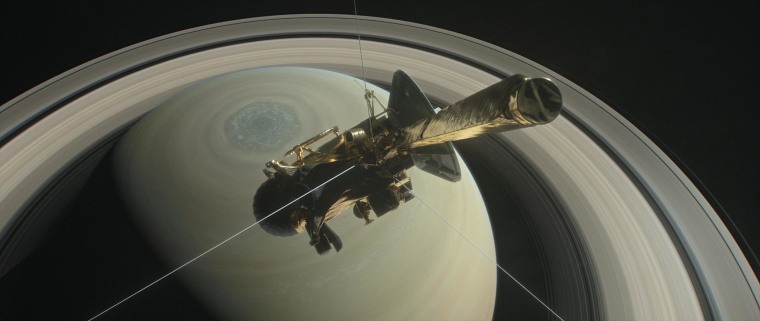After decades in space and a journey of more than 4.1 billion miles, NASA’s Cassini orbiter is set for its grand finale. On April 26, the school bus-sized craft will alter its orbit around Saturn, diving between the sixth planet and its celebrated rings for a closer look.
Mission scientists know that as Cassini passes through the 1,500-mile-wide gap, it could collide with the rocks that make up the rings. But they’re undeterred by that possibility.
“There is definitely an element of risk,” Dr. Curt Niebur, Cassini program scientist at NASA headquarters in Washington, D.C., told NBC News MACH in an email. “We are traveling through a completely unexplored area at extremely high speeds on a path threading the smallest eye of the smallest of needles.”
Related: Saturn’s Moons Show More Signs They Could Support Life
Why send Cassini into harm’s way? Niebur and his colleagues hope the orbiter's plunge will reveal new insights impossible to obtain any other way.
“Some of the big unanswered questions are the way in which the rings formed, the age of the rings, and their mass,” Dr. Jim Fuller, a theoretical astrophysicist at Caltech in Pasadena, California, told NBC News MACH in an email. “If Cassini can measure the total mass of the rings, this will help us understand how the rings formed and how long they've been around.”
The answers to those questions, in turn, could help scientists understand how gas giants like Saturn form and evolve and how the other planets in our solar system came to be, Fuller said. They could also help us understand how planets form around other stars.
Cassini launched in 1997, flying by Venus and Jupiter on its way to Saturn, where its captured close-up images of the planet and its rings. The spacecraft has made some spectacular discoveries, including finding rivers flowing on one of its moons, Titan, and ice volcanoes on another, Enceladus.
The maneuver is a prelude to Cassini’s final, fatal plunge into Saturn, now set for September 15. NASA says Cassini will continue to send back data until the signal is lost, indicating the craft has met its ultimate fate.
